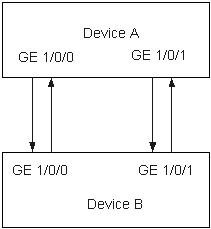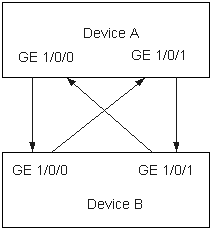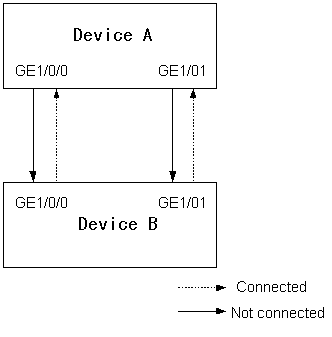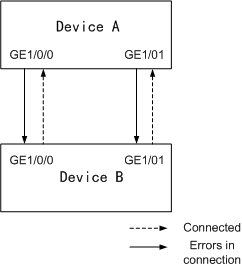DLDP_1.3.6.1.4.1.2011.5.25.173.3.1 hwDldpUnidirectionalLink
Description
DLDP/4/DETECTUNIDIRECT(t): OID [oid] The port is detected in one way status. (IfIndex=[integer], IfName=[STRING])
A unidirectional link is detected in either of the following situations:
Single-neighbor mode: If one of the two connected devices can receive packets from the remote device but the remote device cannot receive packets from the local device, the two devices are connected unidirectionally.
Multi-neighbor mode: A device detects that one of its neighbors is in unidirectional state or the device receives the disable packet.
Attribute
| Alarm ID | Alarm Severity | Alarm Type |
|---|---|---|
| 1.3.6.1.4.1.2011.5.25.173.3.1 | Warning | equipmentAlarm(5) |
Parameters
| Name | Meaning |
|---|---|
| [oid] | Indicates the MIB object ID of the alarm. |
| IfIndex | Indicates the index of the interface where the unidirectional communication alarm is generated. |
| IfName | Indicates the name of the interface where the unidirectional communication alarm is generated. |
Possible Causes
To ensure bidirectional communication between interfaces, establish a bidirectional connection between the interfaces. The interfaces can be connected through optical fibers or twisted-pair cables.
Figure 1 shows the correct connection between interfaces using two pairs of interfaces on two devices as an example.
This alarm is generated in one of the following situations.
1. Interfaces of the two devices are not connected one to one, as shown in Figure 2.
2. One or more cables are disconnected, as shown in Figure 3.
3. Links are disconnected because of faults, as shown in Figure 4.
Procedure
- Run the display
dldp command in the system view to check the DLDP
unidirectional-shutdown field. The DLDP unidirectional-shutdown field specifies the mode in which an interface is disabled when
a unidirectional link is detected. Perform the following operations
according to the DLDP unidirectional-shutdown field value:
If the DLDP unidirectional-shutdown field displays manual, the interface is disabled manually.
Run the shutdown command in the interface view to disable the interface from sending or receiving packets. Then go to step 2.
If the DLDP unidirectional-shutdown field displays auto, the interface is disabled automatically.
The system sends logs and traps automatically and sets the interface status to Block. Go to step 2.
- Check whether devices are cross-connected.
If so, connect the devices correctly and go to step 4.
If not, go to step 3.
- Check whether the physical connection between the two devices
is correct.
If so, go to step 5.
If not, connect the optical fiber or twisted-pair cable to the two devices and go to step 4.
If any of the following situations occur, the physical connection between the two devices is incorrect:- An optical fiber is disconnected.
- The twisted-pair cable is disconnected.
- Check whether the alarm is cleared.
If so, go to step 7.
If not, go to step 5.
- Check whether any optical fiber or twisted-pair cable is
damaged.
If so, replace the optical fiber or twisted-pair cable and go to step 4.
If not, go to step 6.
- Contact technical support personnel.
- End.
The following situations indicate that the fault is rectified:
- The alarm is not displayed on the NMS.
- This alarm is not displayed in the display trapbuffer command output.
- This alarm is not displayed when you run the terminal monitor or terminal trapping command.




